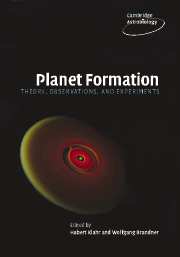Book contents
- Frontmatter
- Contents
- Preface
- Acknowledgments
- 1 Historical notes on planet formation
- 2 The Formation and Evolution of Planetary Systems: placing our Solar System in context
- 3 Destruction of protoplanetary disks by photoevaporation
- 4 Turbulence in protoplanetary accretion disks: driving mechanisms and role in planet formation
- 5 The origin of solids in the early Solar System
- 6 Experiments on planetesimal formation
- 7 Dust coagulation in protoplanetary disks
- 8 The accretion of giant planet cores
- 9 Planetary transits: a first direct vision of extrasolar planets
- 10 The core accretion–gas capture model for gas-giant planet formation
- 11 Properties of exoplanets: a Doppler study of 1330 stars
- 12 Giant-planet formation: theories meet observations
- 13 From hot Jupiters to hot Neptunes … and below
- 14 Disk–planet interaction and migration
- 15 The brown dwarf–planet relation
- 16 Exoplanet detection techniques – from astronomy to astrobiology
- 17 Overview and prospective in theory and observation of planet formation
- References
- Index
15 - The brown dwarf–planet relation
Published online by Cambridge University Press: 14 September 2009
- Frontmatter
- Contents
- Preface
- Acknowledgments
- 1 Historical notes on planet formation
- 2 The Formation and Evolution of Planetary Systems: placing our Solar System in context
- 3 Destruction of protoplanetary disks by photoevaporation
- 4 Turbulence in protoplanetary accretion disks: driving mechanisms and role in planet formation
- 5 The origin of solids in the early Solar System
- 6 Experiments on planetesimal formation
- 7 Dust coagulation in protoplanetary disks
- 8 The accretion of giant planet cores
- 9 Planetary transits: a first direct vision of extrasolar planets
- 10 The core accretion–gas capture model for gas-giant planet formation
- 11 Properties of exoplanets: a Doppler study of 1330 stars
- 12 Giant-planet formation: theories meet observations
- 13 From hot Jupiters to hot Neptunes … and below
- 14 Disk–planet interaction and migration
- 15 The brown dwarf–planet relation
- 16 Exoplanet detection techniques – from astronomy to astrobiology
- 17 Overview and prospective in theory and observation of planet formation
- References
- Index
Summary
Introduction
Given that brown dwarfs are usually much more massive than planets (see Section 15.6), it is somewhat surprising that the first incontrovertible discovery of a brown dwarf (Nakajima et al., 1995) and the discovery of the first extrasolar planet (Mayor and Queloz, 1995) were announced simultaneously in 1995. Over the past decade, the rapid progress made in both fields has been extraordinary. There are now more than 150 extrasolar planets known, including more than a dozen multiple-planet systems. The first brown dwarf, Gliese 229B, was found in orbit around an M-dwarf, but in the same year other candidates, later confirmed to be free-floating brown dwarfs, were announced (e.g. Teide 1 by Rebolo et al., 1995), along with PPl 15 which was later discovered to be a binary brown dwarf (Basri and Martin, 1999). Observations now suggest that brown dwarfs are as common as stars, although stars dominate in terms of mass (e.g. Reid et al., 1999).
Since the rest of this book is devoted to the topic of planets, in this chapter I will review the properties and potential formation mechanisms of brown dwarfs, comparing and contrasting them with planets, but referring the reader to the other chapters of the book for detailed information on planets.
Masses
The most fundamental parameter of a brown dwarf is its mass.
- Type
- Chapter
- Information
- Planet FormationTheory, Observations, and Experiments, pp. 236 - 249Publisher: Cambridge University PressPrint publication year: 2006

